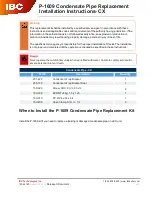
18-CG03D1-4
24
Be sure to use stainless steel liners, such as stainless
types 430, 304, or for the toughest corrosion pro-
blems, type 316. If the chimney is the correct size for
the unit and condensing still occurs, then insulating
the vent connector and/or reducing the effi ciency of
the boiler may have to be done to raise the chimney
temperature.
More detailed information may be obtained from the
latest edition of the ASHRAE HVAC Systems and
Equipment Handbook.
Should the previous recommendations and informa-
tion obtained from the ASHRAE Handbook fail to
resolve a condensate problem, another alternative to
consider is power side wall venting..
DRAFT REGULATORA - required when using
BAYRAF burners
A 6” barometric-type, draft regulator is supplied with
the boiler. This 6” draft regulator is approved for use
with the 5” vent system required for this boiler when
using BAYRAF model oil burners. The draft regulator
includes an adjustable collar capable of fi tting 5” 6”
or 7” vent pipe. The draft regulator is calibrated to
allow for easy adjustment to the boiler manufactu-
rer’s specifi cations. Designed for settings from .02” to
.08”. Instrumentation should be used when adjusting
the unit during installation. Installation or operating
conditions that produce excess amounts of draft can
reduce the heating effi ciency of the boiler. The pur-
pose of the regulator is to adjust and control the fl ow
of fl ue gases from the boiler by stabilizing the amount
of chimney draft to which the boiler is subjected.
Install the barometric draft regulator in the vent
connector as close as possible to the fl ue outlet collar
of the boiler. However, always refer to the draft
regulator manufacturer’s installation instructions for
application specifi c recommendations.
PREVENTION OF CHIMNEY CONDENSING:
PROPER VENTING REQUIRED!
Improper venting may lead to condensation in the
chimney. This may result in property damage, injury,
or loss of life. To prevent condensation refer to NFPA
31 Section 6 and Appendix E.
Stack gas may do one of two things as it escapes up
the chimney:
A. Remain entirely in a gaseous state if the internal
chimney wall temperature is above the dew point, or
B. Condense water vapor on the chimney walls if they
are chilled below the dew point.
Condensing will always occur on chimney walls
whose temperatures are below the dew point, but
the condensate may evaporate when the walls warm
above the dew point. If the chimney wall temperature
does not exceed the dew point during the heating
cycle of the boiler, the moisture may accumulate in
large enough quantities to cause problems such as
corrosion of a metal chimney (especially plain steel or
galvanized steel), erosion and break up of a tile liner
in a masonry chimney and, in severe cases, corrosion
of the heat exchanger. Condensate also could enter
the home through cracks or joints in the chimney in a
worse case situation.
Condensation most likely will not occur at the bottom
of the chimney because the stack gas heats the chi-
mney walls as it rises and the bottom will be heated
fi rst. This heating of the walls will cause the stack
gas temperature to drop, which in turn may reduce
the stack gas temperature below dew point, causing
condensation to appear on the upper part of the
chimney fi rst. This condensation may then run down
inside the chimney and drip back as far as the fl ue
pipe and heat exchanger, where corrosion may occur,
if not treated.
To prevent condensation, it is necessary that the
internal chimney wall temperature always be kept
above the dew point. If the chimney is a masonry
type, it may have to be fi tted with a fl ue liner, when
the temperature loss is too great for the boiler. If the
chimney is a metal type, then an “all fuel” chimney
must be used, such as a Class “A” triple wall or insu-
lated metal chimney. A liner will act as an insulator
and reduce the stack gas temperature loss. Insulation
may be added around the liner for further tempera-
ture stability. If the chimney is on the home’s exterior
or passes through a sizable, unheated area of the
building, such as a porch, high ceiling attic, etc., and
condensing occurs, the chimney must be insulated
around its exterior to help the fl ue hold its tempera-
ture. Also, check to see if the chimney is too large for
the boiler and other appliances connected to it. If so,
reduce to proper size (see Appendix E of NFPA31) by
lining.
















































